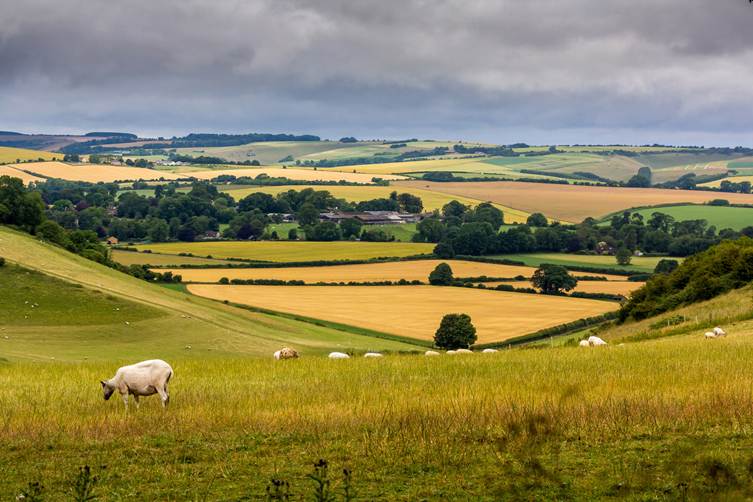By Anna Woodley from Trinity AgTech
For generations, farmers have been finely tuned to the physical and financial cycles of their land – balancing input costs with yield, timing the market, and managing unpredictable weather. The ability to manage complexity and make it pay is a defining skill of British agriculture. But in a rapidly changing farming landscape, one question is becoming more urgent: do you really know the hidden £ value of your farm’s natural capital?
Not in terms of selling carbon credits or biodiversity units – though those may come later – but in terms of the everyday value your natural assets provide to your core business: producing food, efficiently and profitably.
The idea is simple. If your soil, water, biodiversity and other natural systems were treated as productive assets – not just background variables – how might that change your farm performance? And what if optimising those systems was the key to reducing your cost of production, improving animal health, and making your farm more resilient?
Natural Capital: A Working Definition
Natural capital refers to the stock of natural resources on your land – like soil, water, plant biomass, biodiversity, and air quality – that provide essential services for food production. These services include nutrient cycling, pollination, pest control, water regulation, and carbon storage.
While some of these benefits are invisible day-to-day, they underpin the physical productivity and financial performance of your farm. Take soil, for instance. A biologically active, well-structured soil holds more water, releases nutrients more efficiently, reduces fertiliser needs and improves grass growth. That’s not an environmental nicety – it’s a productivity engine.
The Real-World Payback: Improving Soils, Reducing Costs
Start with a grass sward, after all 58% of the UK’s farmed land is under permanent grass. The quality of permanent grasslands for grazing is fundamentally shaped by soil biology and carbon levels. Soils with higher organic matter and healthy microbial life cycle nutrients more effectively. That means higher forage quality, better digestibility, and more consistent growth across the season.
A 1% increase in soil organic matter can improve water holding capacity by over 20,000 litres per hectare, reduce nutrient leaching, and increase nutrient-use efficiency. Soil biology supports the release of up to 70 kg of nitrogen per hectare annually, reducing the need for expensive and emission-heavy synthetic fertilisers.
For livestock farmers, this translates into better feed conversion, reduced reliance on supplementary feed, and improved liveweight gains. It also reduces methane emissions at source, as higher-quality forage reduces the energy lost through enteric fermentation. Trials have shown that improved forage quality can reduce methane emissions from enteric fermentation by up to 17% while supporting better daily weight gain.
Healthier soils reduce worm burdens and hoof problems by improving drainage and structure. The result? Fewer vet bills and more consistent productivity.
Across the farm system, the savings add up:
- Lower artificial fertiliser costs, as nutrients are recycled more effectively.
- Reduced supplementary feed requirements.
- Fewer inputs to treat disease or manage compaction.
- Better water infiltration and drought resilience.
Now consider the arable system. Soil structure and biology play a similar role in boosting margins. Improving soil organic matter through reduced tillage and cover cropping can increase yields by up to 10%, while reducing diesel use and improving machinery workability.
Better soil structure enables more even germination, fewer compaction-related losses, and more resilient crops during dry spells. Integrating legumes into rotation can fix up to 150 kg of nitrogen per hectare, dramatically reducing synthetic fertiliser use.
Farmers adopting cover crops and reduced tillage on UK arable land have reported input savings of £60-£90/ha, alongside improved soil resilience and yield stability.

Understanding the Linkages: Soil, Plant, Animal, Profit
Let’s take a concrete example. A farm with improved soil biology – supported by diverse swards, minimal disturbance, and cover cropping – builds soil carbon. This carbon stores water, buffers against pH swings, and creates a habitat for fungi and bacteria that unlock nitrogen and phosphorus from the soil profile.
Grass grown in this context tends to have better mineral content, higher sugar levels and improved digestibility. Animals grazing it convert forage more efficiently into meat or milk. Methane intensity per kg of output goes down. Feed inputs can be lowered without compromising performance. Animal health improves due to better trace element availability and reduced stress.
The science supports it. High-WSC (water-soluble carbohydrate) grasses improve rumen fermentation and nitrogen-use efficiency, while better pasture mineral content improves immune function. Reduced stress and more consistent nutrition lower disease incidence.
In arable systems, the principle holds. Soil biology improves root development and nutrient availability. That means more even establishment, stronger crop competition with weeds, and lower pesticide needs. A well-functioning soil food web can supply up to 60% of a cereal crop’s nitrogen needs and reduce phosphate requirements by mobilising legacy P from the soil bank.
Cover cropping with species like radish, vetch, and phacelia not only protects soil but primes it with biological activity. Fields following multi-species cover crops often show better yield stability, higher soil carbon, and reduced run-off.
This is natural capital in action. Not a theory, not a market commodity, but a system of living assets quietly delivering commercial value.
Sandy: A Tool to Quantify and Optimise
While many farmers already work intuitively with nature, new technologies are emerging to quantify these benefits and support decision-making. Sandy, the natural capital navigation and intelligence platform developed by Trinity AgTech, helps farmers understand how their soils, habitats, and farm management choices affect both environmental outcomes and financial performance.
Using Sandy, farmers can:
- Assess how soil carbon and biology affect grass growth and feed quality.
- Model the effect of management changes (e.g. reduced tillage, herbal leys) on soil function and nutrient use.
- Understand how improved forage quality impacts livestock emissions and feed costs.
- Track improvements in animal welfare linked to better natural asset function.
- Calculate the nutrient and cost benefits of integrating legumes or cover crops.
- Quantify financial opportunities and risks associated with changing practises
This level of insight supports practical, everyday decisions: which fields are most cost-effective to reseed? Where is soil function limiting productivity? Which interventions deliver the best return on investment?
The platform is built on peer-reviewed science, aligned with UK and international standards, and trusted by farmers and supply chain partners alike. It connects nature-based decisions directly to profitability.
A Foundation for Resilience
Can your farm evolve to thrive through extremes? Natural capital is also your farm’s insurance policy. Fields that hold water better are less vulnerable to drought. Pastures with diverse root systems recover faster after stress. Soils rich in organic matter are more resilient to compaction and erosion. In the face of climate extremes and market volatility, the farm with healthy natural systems is the farm that adapts.
What if you had a clear map of how your land stands-up to drought, flooding, rising costs and market volatility?
By managing natural capital proactively, farmers increase not just yields, but consistency. They reduce their dependence on expensive external inputs. They lower environmental risks. And they build a business that can thrive under future regulation and consumer scrutiny.
And Yes, Markets Will Come
Once a farm has a clear understanding of the value and function of its natural capital, opportunities for new income streams follow. Carbon markets, biodiversity net gain, water quality trading and supply chain premiums all require robust, credible data, backed by science-based evidence. Sandy helps generate that evidence – but the point is, the farm is already benefitting before any credit is sold.
Nature markets should be seen as a happy by-product of smart land management – not the starting point. The core driver should be the production of healthy, nutritious food alongside improved productivity, profitability, and resilience.
A Change of Mindset
This shift is not about turning farmers into ecologists or accountants. It’s about extending what good farmers already do: observe, adapt, and improve. It’s about treating soil, water, carbon and biodiversity not as externalities but as working parts of an inter-connected, nested system.
It’s also about asking better questions:
- Where are my natural assets underperforming?
- What’s the cost to my business of degraded soil or low-functioning pastures?
- What would it mean for my margins if I could reduce inputs by 10%?

Answering these questions doesn’t require guesswork anymore. It requires tools like Sandy, good insights, and a willingness to see the full value of what the land provides.
In Summary
Your farm’s natural capital isn’t just an environmental concern. It’s the foundation of your profitability. From soil structure to grass quality, from animal health to input costs, the function of natural systems determines the efficiency of your food production.
By understanding, measuring and improving these assets, farmers can:
- Reduce costs of production.
- Improve crop performance
- Improve animal performance and welfare.
- Increase resilience to climate and market shocks.
- Unlock new income in ecosystem service markets.
And all of this starts by recognising that your natural capital is not hidden at all. It’s right under your feet.
To learn more about how Sandy can help you quantify and improve your farm’s natural capital, visit www.trinityagtech.com



